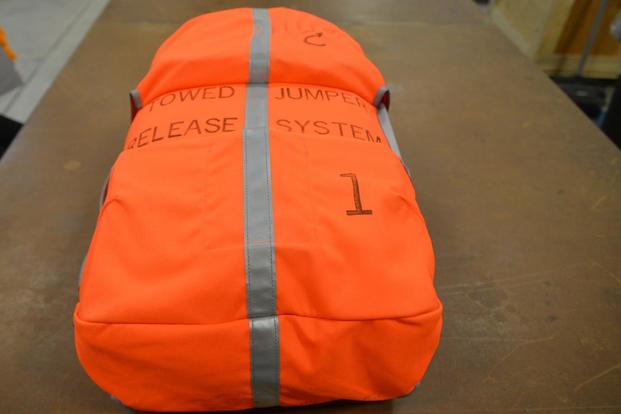U.S. Army experts are testing a new emergency parachute system that can be used when a paratrooper becomes a towed jumper -- a dangerous malfunction that causes an individual to be dragged behind the aircraft.
While Army airborne operations have evolved over the decades into a safe science, there are still hazards to static-line parachute jumps that can be deadly. A paratrooper becomes a towed jumper when the static line, or cord that's attached to a special cable inside the aircraft, fails to pull the jumper's main parachute open.
"A towed jumper situation is very, very dangerous," Sam Corner, project manager for the U.S. Army Research, Development and Engineering Command Soldier Center Aerial Delivery Directorate, told Military.com on Thursday.
While it doesn't occur often, "it can lead to very serious injury or death. There have been fatalities every year, not just in the U.S., but across foreign militaries as well," he said, describing how the static line can get "wrapped up on an arm. If you have a bad exit, it can get wrapped up on equipment."
Corner is leading an effort to convince the airborne community to adopt what has become known as the Towed Jumper Recovery System, a special emergency parachute that jumpmasters can attach to towed jumpers to ensure they land safely, he said.
The TJRS, made by Airborne Systems North America, is a modification of a British system known as the Hung Up Parachutist Release Assembly, or HUPRA.
"Right now, the two options that they have once the malfunction is detected is to either release the jumper if they are conscious and able to activate their reserve parachute or attempt to pull them back into the aircraft. There is a winch in the aircraft that pulls them back in, which can be as dangerous if not more as the actual towing," Corner said, describing how it's common for a towed jumper to bang repeatedly against the side of the aircraft.
The TJRS, which is essentially an extra T11 parachute, is contained in a deployment bag that can be carried onto the aircraft.
Once the towed jumper is identified, aircraft personnel unpack the TJRS. The deployment bag for the recovery parachute attaches to the floor of the aircraft with a carabiner, Corner said.
Then a lanyard is routed through all of the static-line snap hooks that are attached to the aircraft's anchor-line cable. Normally, used static lines are pulled back into the aircraft after all the jumpers have exited.
"It's just a metal rod that we thread through; that way we don't have to try and determine which static line hook belongs to the towed jumper ... and then that loop gets linked back to the recovery parachute," Corner said.
Once everything is inspected, aircraft personnel "actually cut the aircraft's anchor line cable," which releases all of the static lines and deployment bags, including the one belonging to the towed jumper, he said, adding that this starts the deployment of the recovery parachute.
If it all works correctly, the T11 canopy opens with all of the static lines attached beneath it, including the one attached to the towed jumper.
Corner's team recently wrapped up testing the TJRS at Yuma Proving Ground, Arizona.
Since it uses a standard T11 parachute, the system can support up to 450 pounds, including the jumper's weight and all the weapons and equipment carried on the jump, Corner said.
During the evaluation, the team "tested cutting the anchor line cable so we could see what would happen when we cut [it] under load," he said. "Is it going to rebound through the aircraft? ... It turns out it just drops to the floor, which is nice."
The tests also included about 25 drops using mannequins thrown out of a C-130A Hercules aircraft. So far, the system has not been tested using live paratroopers, Corner said.
"There is no formal requirement yet," he said, adding that the Army has been briefing the concept to the Army Airborne Board for the past few years.
The plan is to use the results to "hopefully get a requirement drafted so this can move onto a program of record," Corner said. "Our goal here is to save lives and to provide the best tools that we can."
-- Matthew Cox can be reached at matthew.cox@military.com.









